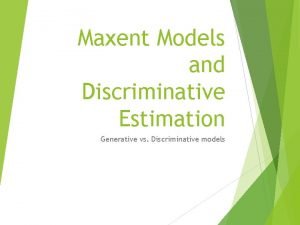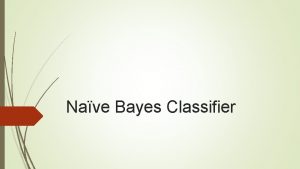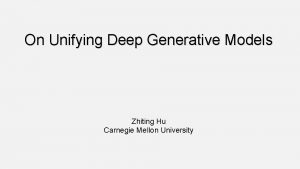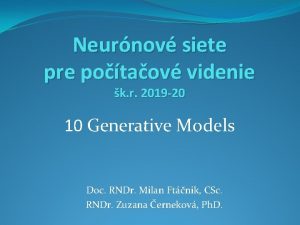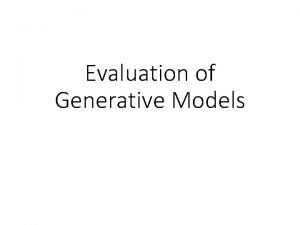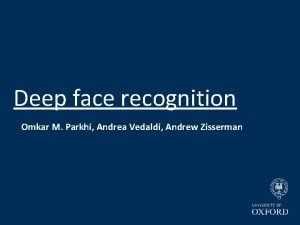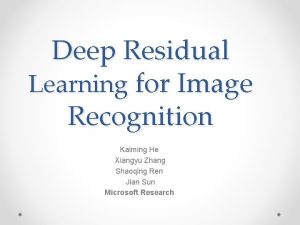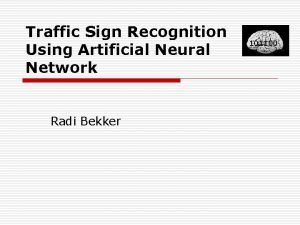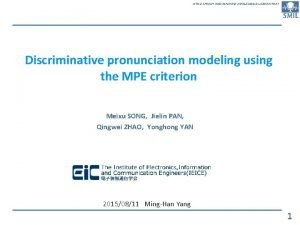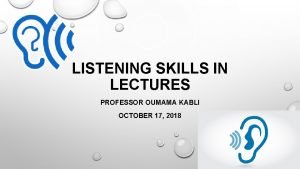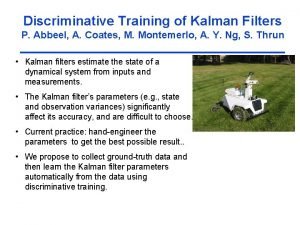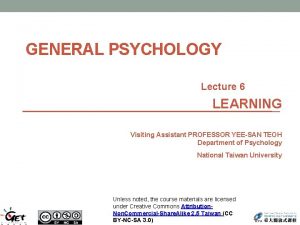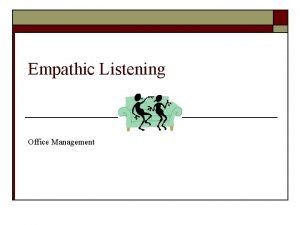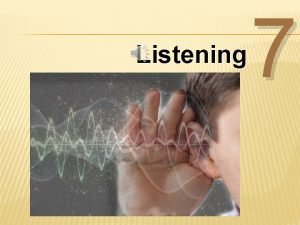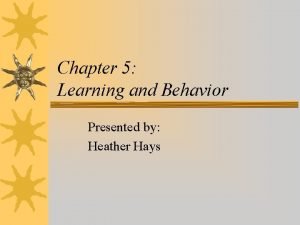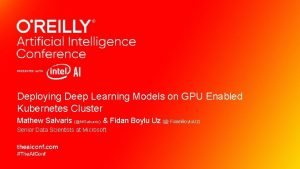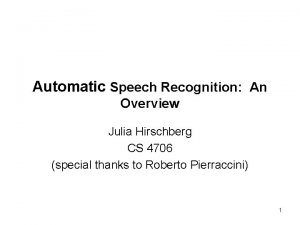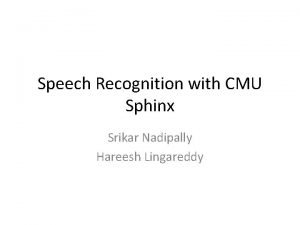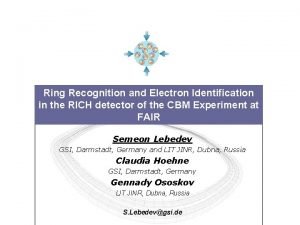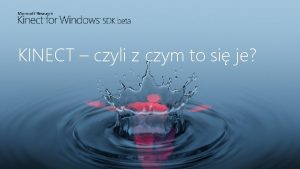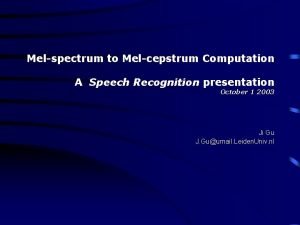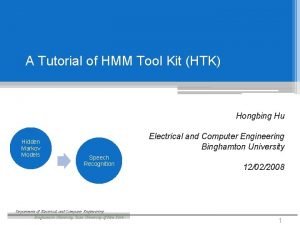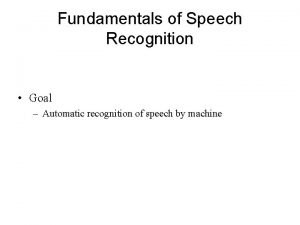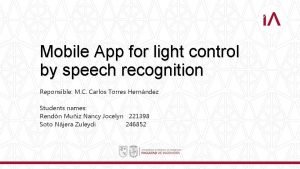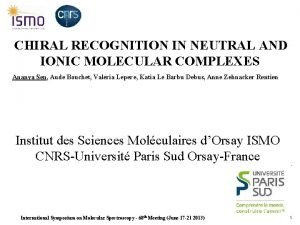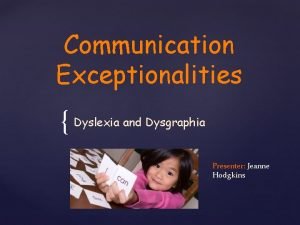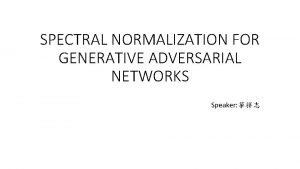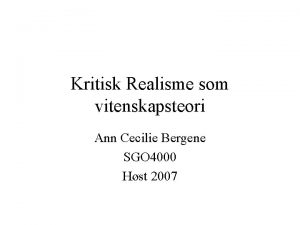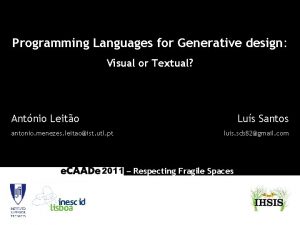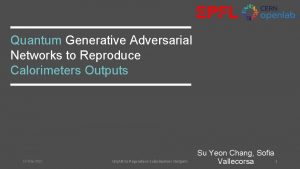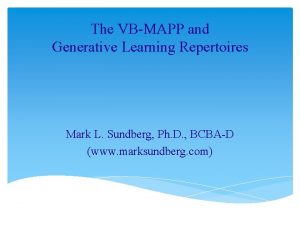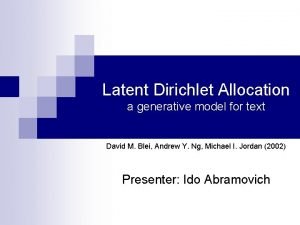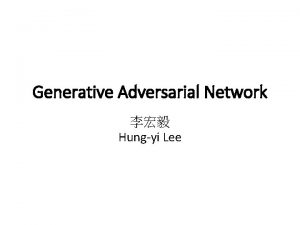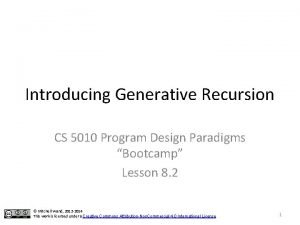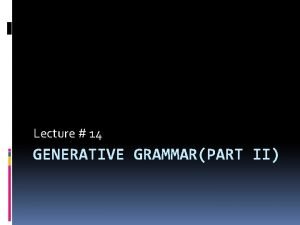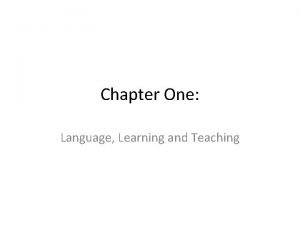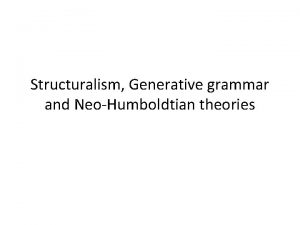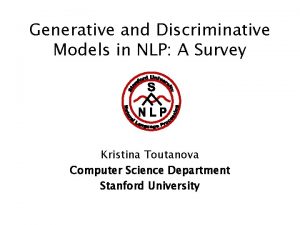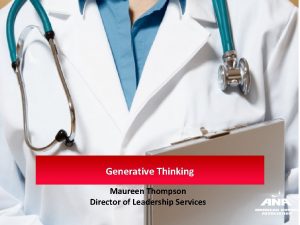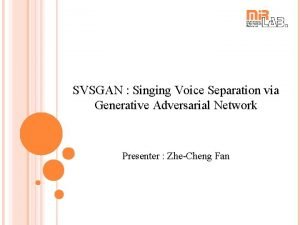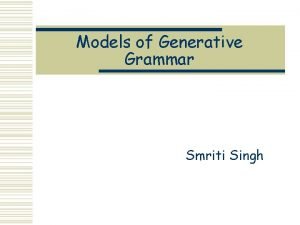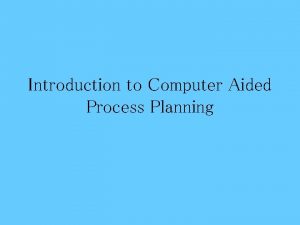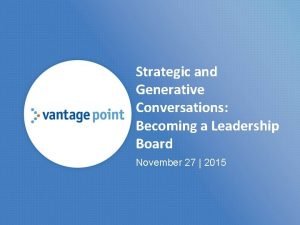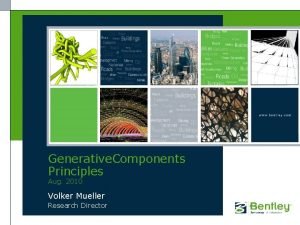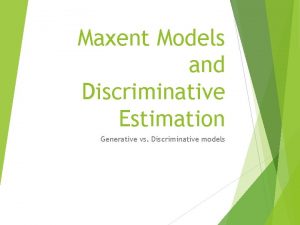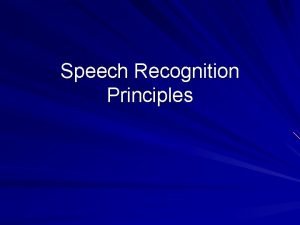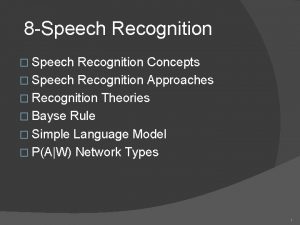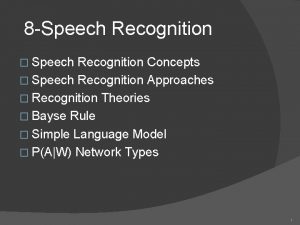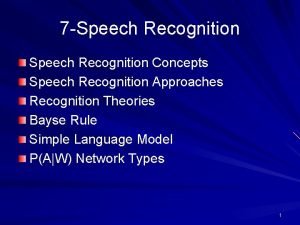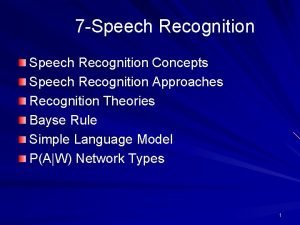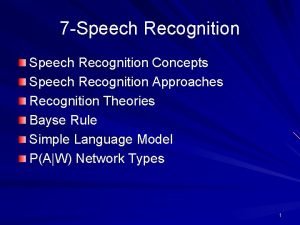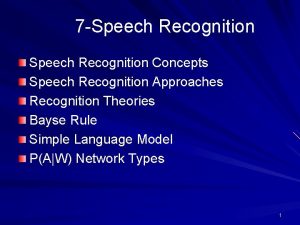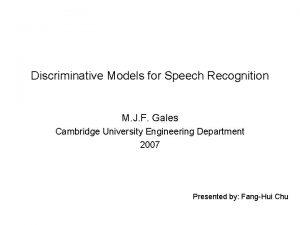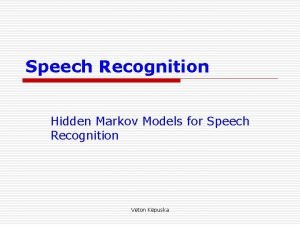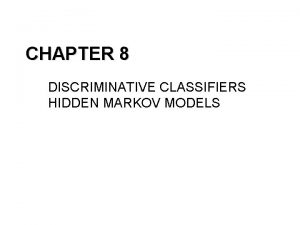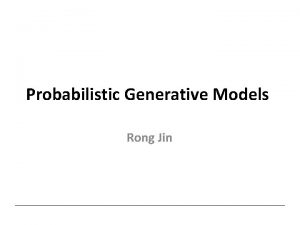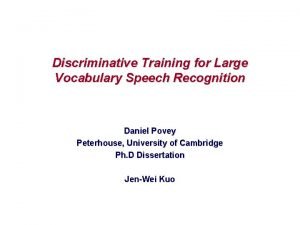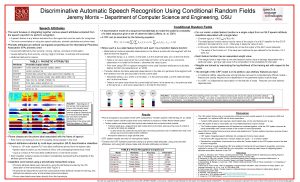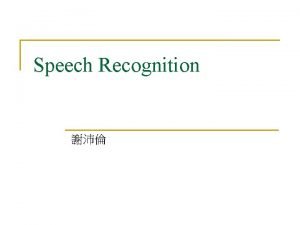Deep Generative Discriminative Models for Speech Recognition Li





























































- Slides: 61

Deep Generative & Discriminative Models for Speech Recognition Li Deng Deep Learning Technology Center Microsoft Research, Redmond, USA Machine Learning Conference, Berlin, Oct 5, 2015 Thanks go to many colleagues at DLTC/MSR, collaborating universities, and at Microsoft’s engineering groups

Outline • Introduction • Part I: Some history • How deep learning entered speech recognition (2009 -2010) • Generative & discriminative models prior to 2009 • Part II: State of the art • Dominated by deep discriminative models • Deep neural nets (DNN) & many of the variants • Part III: Prospects • Integrating deep generative/discriminative models • Deep multimodal and semantic modeling 2

Recent Books on the Topic L. Deng and D. Yu (2014) "Deep Learning: Methods and Applications, “ NOW Publishers http: //research. microsoft. com/pubs/209355/Deep. Learning-Now. Publishing-Vol 7 -SIG-039. pdf D. Yu and L. Deng (2014). "Automatic Speech Recognition: A Deep Learning Approach, ” Springer. A. Graves (2012) “Supervised Sequence Labeling with Recurrent Neural Nets, ” Springer. J. Li, L. Deng, R. Haeb-Umbach, Y. Gong (2015) “Robust Automatic Speech Recognition --- A bridge to practical applications, ” Academic Press. A Deep-Learning Approach 3

1060 -1089 4

Deep Discriminative NN Deep Generative Models Structure Graphical; info flow: bottom-up Graphical; info flow: top-down Incorp constraints & domain knowledge Harder; less fine-grained Easier; more fine grained Semi/unsupervised Hard or impossible Easier, at least possible Interpretation Harder Easy (generative “story” on data and hidden variables) Representation Distributed Localist (mostly); can be distributed also Inference/decode Easy Harder (but note recent progress) Scalability/compute Easier (regular computes/GPU) Harder (but note recent progress) Incorp. uncertainty Hard Easy Empirical goal Classification, feature learning, … Classification (via Bayes rule), latent variable inference… Terminology Neurons, activation/gate functions, weights … Random vars, stochastic “neurons”, potential function, parameters … Learning algorithm A single, unchallenged, algorithm -- Back. Prop A major focus of open research, many algorithms, & more to come Evaluation On a black-box score – end performance On almost every intermediate quantity Implementation Hard (but increasingly easier) Standardized but insights needed Experiments Massive, real data Modest, often simulated data Parameterization Dense matrices Sparse (often PDFs); can be dense

Outline • Introduction • Part I: Some history • How deep learning entered speech recognition (2009 -2010) • Generative & discriminative models prior to 2009 • Part II: State of the art • Dominated by deep discriminative models • Deep neural nets (DNN) & many of the variants • Part III: Prospects • Integrating deep generative/discriminative models • Deep multimodal and semantic modeling 6

(Shallow) Neural Networks for Speech Recognition (prior to the rise of deep learning 2009 -2010) Temporal & Time-Delay (1 -D Convolutional) Neural Nets • Atlas, Homma, and Marks, “An Artificial Neural Network for Spatio-Temporal Bipolar Patterns, 1988 Application to Phoneme Classification, ” NIPS, 1988. • Waibel, Hanazawa, Hinton, Shikano, Lang. “Phoneme recognition using time-delay neural 1989 networks. ” IEEE Transactions on Acoustics, Speech and Signal Processing, 1989. Hybrid Neural Nets-HMM 1990 • Morgan and Bourlard. “Continuous speech recognition using MLP with HMMs, ” ICASSP, 1990. Recurrent Neural Nets • Bengio. “Artificial Neural Networks and their Application to Speech/Sequence Recognition”, Ph. D. 1991 thesis, 1991. • Robinson. “A real-time recurrent error propagation network word recognition system, ” ICASSP 1992 Neural-Net Nonlinear Prediction • Deng, Hassanein, Elmasry. “Analysis of correlation structure for a neural predictive model with applications to speech recognition, ” Neural Networks, vol. 7, No. 2, 1994 Bidirectional Recurrent Neural Nets • Schuster, Paliwal. "Bidirectional recurrent neural networks, " IEEE Trans. Signal Processing, 1997 Neural-Net TANDEM • Hermansky, Ellis, Sharma. "Tandem connectionist feature extraction for conventional HMM 2000 systems. " ICASSP 2000. • Morgan, Zhu, Stolcke, Sonmez, Sivadas, Shinozaki, Ostendorf, Jain, Hermansky, Ellis, Doddington, Chen, Cretin, Bourlard, Athineos, “Pushing the envelope - aside [speech recognition], ” IEEE Signal 2005 Processing Magazine, vol. 22, no. 5, 2005. DARPA EARS Program 2001 -2004: Novel Approach I (Novel Approach II: Deep Generative Model) Bottle-neck Features Extracted from Neural-Nets • Grezl, Karafiat, Kontar & Cernocky. “Probabilistic and bottle-neck features for LVCSR of meetings, ” 2007 ICASSP, 2007. 7


Deep Generative Models for Speech Recognition (prior to the rise of deep learning) Segment & Nonstationary-State Models • • Digalakis, Rohlicek, Ostendorf. “ML estimation of a stochastic linear system with the EM alg & application to speech recognition, ” IEEE T-SAP, 1993 Deng, Aksmanovic, Sun, Wu, Speech recognition using HMM with polynomial regression functions as nonstationary states, ” IEEE T-SAP, 1994. 1993 1994 Hidden Dynamic Models (HDM) • • Deng, Ramsay, Sun. “Production models as a structural basis for automatic speech recognition, ” Speech Communication, vol. 33, pp. 93– 111, 1997. Bridle et al. “An investigation of segmental hidden dynamic models of speech coarticulation for speech recognition, ” Final Report Workshop on Language Engineering, Johns Hopkins U, 1998. Picone et al. “Initial evaluation of hidden dynamic models on conversational speech, ” ICASSP, 1999. Deng and Ma. “Spontaneous speech recognition using a statistical co-articulatory model for the vocal tract resonance dynamics, ” JASA, 2000. 1997 1998 1999 2000 Structured Hidden Trajectory Models (HTM) • • Zhou, et al. “Coarticulation modeling by embedding a target-directed hidden trajectory model into HMM, ” ICASSP, 2003. DARPA EARS Program 2001 -2004: Novel Approach II Deng, Yu, Acero. “Structured speech modeling, ” IEEE Trans. on Audio, Speech and Language Processing, vol. 14, no. 5, 2006. 2003 2006 Switching Nonlinear State-Space Models • Deng. “Switching Dynamic System Models for Speech Articulation and Acoustics, ” in Mathematical Foundations of Speech and Language Processing, vol. 138, pp. 115 - 134, Springer, 2003. • Lee et al. “A Multimodal Variational Approach to Learning and Inference in Switching State Space Models, ” ICASSP, 2004. 9

Deterministic HDM Statistical HDM Bridle, Deng, Picone, Richards, Ma, Kamm, Schuster, Pike, Reagan. Final Report for Workshop on Language Engineering, 10 Johns Hopkins University, 1998.

HDM: A Deep Generative Model of Speech Production/Perception --- Perception as “variational inference” (1997 -2007) SPEAKER targets articulation message distortion-free acoustics ors ulat rtic or/a mot distorted acoustics Speech Acoustics distortion factors & feedback to articulation

ICASSP-2004 Auxiliary function: 12

Surprisingly Good Inference Results for Continuous Hidden States • By-product: accurately tracking dynamics of resonances (formants) in vocal tract (TIMIT & SWBD). • Best formant tracker by then in speech analysis; used as basis to form a formant database as “ground truth” • We thought we solved the ASR problem, except • “Intractable” for decoding Deng & Huang, Challenges in Adopting Speech Recognition, Communications of the ACM, vol. 47, pp. 69 -75, 2004. Deng, Cui, Pruvenok, Huang, Momen, Chen, Alwan, A Database of Vocal Tract Resonance Trajectories for Research in Speech , ICASSP, 2006. 13

Another Deep Generative Model (developed outside speech) • Sigmoid belief nets & wake/sleep alg. (1992) • Deep belief nets (DBN, 2006); Start of deep learning • Totally non-obvious result: Stacking many RBMs (undirected) not Deep Boltzmann Machine (DBM, undirected) but a DBN (directed, generative model) • Excellent in generating images & speech synthesis • Similar type of deep generative models to HDM • But simpler: no temporal dynamics • With very different parameterization • Most intriguing of DBN: inference is easy (i. e. no need for approximate variational Bayes) ”Restriction” of connections in RBM • Pros/cons analysis Hinton coming to MSR 2009 14

This is a very different kind of deep generative model (Mohamed, Dahl, Hinton, 2009, 2012) (after adding Backprop to the generative DBN) (Deng et al. , 2006; Deng & Yu, 2007)

Error Analysis d • Elegant model formulation & knowledge incorporation • Strong empirical results: 96% TIMIT accuracy with Nbest=1001; 75. 2% lattice decoding w. monophones; fast approx. training • Still very expensive for decoding; could not ship (very frustrating!) -- DBN/DNN made many new errors on short, undershoot vowels -- 11 frames contain too much “noise” 16

Academic-Industrial Collaboration (2009, 2010) • I invited Geoff Hinton to work with me at MSR, Redmond • Well-timed academic-industrial collaboration: – Speech industry searching for new solutions while “principled” deep generative approaches could not deliver – Academia developed deep learning tools (e. g. DBN 2006) looking for applications – Add Backprop to deep generative models (DBN) DBN-DNN (hybrid generative/discriminative) – Advent of GPU computing (Nvidia CUDA library released 2007 -2008) – Big training data in speech recognition were already available 17

Invitee 1: give me one week to decide …, … Not worth my time to fly to Vancouver for this… Mohamed, Dahl, Hinton, Deep belief networks for phone recognition, NIPS 2009 Workshop on Deep Learning, 2009 Yu, Deng, Wang, Learning in the Deep-Structured Conditional Random Fields, NIPS 2009 Workshop on Deep Learning, 2009 …, …, … 18

Expanding DNN at Industry Scale • Scale DNN’s success to large speech tasks (2010 -2011) – Grew output neurons from context-independent phone states (100 -200) to context-dependent ones (1 k-30 k) CD-DNN-HMM for Bing Voice Search and then to SWBD tasks – Motivated initially by saving huge MSFT investment in the speech decoder software infrastructure – CD-DNN-HMM also gave much higher accuracy than CI-DNN-HMM – Discovered that with large training data Backprop works well without DBN pre-training by understanding why gradients often vanish (patent filed for “discriminative pre-training” 2011) • Engineering for building large speech systems: – Combined expertise in DNN (esp. with GPU implementation) and speech recognition – Collaborations among MSRR, MSRA, academic researchers • • Yu, Deng, Dahl, Roles of Pre-Training and Fine-Tuning in Context-Dependent DBN-HMMs for Real-World Speech Recognition, in NIPS Workshop on Deep Learning, 2010. Dahl, Yu, Deng, Acero, Large Vocabulary Continuous Speech Recognition With Context-Dependent DBN-HMMS, in Proc. ICASSP, 2011. Dahl, Yu, Deng, Acero, Context-Dependent Pre-trained Deep Neural Networks for Large Vocabulary Speech Recognition, in IEEE Transactions on Audio, Speech, and Language Processing (2013 IEEE SPS Best Paper Award) , vol. 20, no. 1, pp. 30 -42, January 2012. Seide, Li, Yu, "Conversational Speech Transcription Using Context-Dependent Deep Neural Networks", Interspeech 2011, pp. 437 -440. Hinton, Deng, Yu, Dahl, Mohamed, Jaitly, Senior, Vanhoucke, Nguyen, Sainath, Kingsbury, Deep Neural Networks for Acoustic Modeling in Speech. Recognition, in IEEE Signal Processing Magazine, vol. 29, no. 6, pp. 82 -97, November 2012 Sainath, T. , Kingsbury, B. , Ramabhadran, B. , Novak, P. , and Mohamed, A. “Making deep belief networks effective for large vocabulary continuous speech recognition, ” Proc. ASRU, 2011. Sainath, T. , Kingsbury, B. , Soltau, H. , and Ramabhadran, B. “Optimization Techniques to Improve Training Speed of Deep Neural Networks for Large Speech Tasks, ” IEEE Transactions on Audio, Speech, and Language Processing, vol. 21, no. 11, pp. 2267 -2276, Nov. 2013. Jaitly, N. , Nguyen, P. , Senior, A. , and Vanhoucke, V. “Application of Pretrained Deep Neural Networks to Large Vocabulary Speech Recognition, ” Proc. Interspeech, 2012. 19

Context-Dependent DNN-HMM Model tied triphone states directly Many layers of nonlinear feature transformation + Soft. Max 20

DNN vs. Pre-DNN Prior-Art Table: TIMIT Phone recognition (3 hours of training) § • � Features Setup Error Rates Pre-DNN Deep Generative Model 24. 8% DNN 5 layers x 2048 23. 4% ~10% relative improvement Table: Voice Search SER (24 -48 hours of training) Features Setup Error Rates Pre-DNN GMM-HMM with MPE 36. 2% DNN 5 layers x 2048 30. 1% ~20% relative improvement Table: Switch. Board WER (309 hours training) Features Setup Pre-DNN GMM-HMM with BMMI Error Rates 23. 6% DNN 7 layers x 2048 15. 8% ~30% relative Improvement For DNN, the more data, the better! 21

Scientists See Promise in Deep-Learning Programs John Markoff November 23, 2012 Rick Rashid in Tianjin, China, October, 25, 2012 Deep learning technology enabled speech-to-speech translation A voice recognition program translated a speech given by Richard F. Rashid, Microsoft’s top scientist, into Mandarin Chinese.

CD-DNN-HMM Dahl, Yu, Deng, and Acero, “Context-Dependent Pretrained Deep Neural Networks for Large Vocabulary Speech Recognition, ” IEEE Trans. ASLP, Jan. 2012 (also ICASSP 2011) Seide et al, Interspeech, 2011. After no improvement for 10+ years by the research community… …MSR reduced error from ~23% to <13% (and under 7% for Rick Rashid’s S 2 S demo in 2012)!

24

Impact of deep learning in speech technology Cortana

Microsoft Research 26

Outline • Introduction • Part I: Some history • How deep learning entered speech recognition (2009 -2010) • Generative & discriminative models prior to 2009 • Part II: State of the art w. further innovations • Dominated by deep discriminative models • Deep neural nets (DNN) & many of the variants • Part III: Prospects • Integrating deep generative/discriminative models • Deep multimodal and semantic modeling 27

Innovation: Better Optimization • Sequence discriminative training for DNN: - Mohamed, Yu, Deng: “Investigation of full-sequence training of deep belief networks for speech recognition, ” Interspeech, 2010. - Kingsbury, Sainath, Soltau. “Scalable minimum Bayes risk training of DNN acoustic models using distributed hessian-free optimization, ” Interspeech, 2012. - Su, Li, Yu, Seide. “Error back propagation for sequence training of CD deep networks for conversational speech transcription, ” ICASSP, 2013. - Vesely, Ghoshal, Burget, Povey. “Sequence-discriminative training of deep neural networks, Interspeech, 2013. • Distributed asynchronous SGD Input data X - Dean, Corrado, …Senior, Ng. “Large Scale Distributed Deep Networks, ” NIPS, 2012. - Sak, Vinyals, Heigold, Senior, Mc. Dermott, Monga, Mao. “Sequence Discriminative Distributed Training of Long Short-Term Memory Recurrent Neural Networks, ” Interspeech, 2014. 28

Innovation: Towards Raw Inputs • Bye-Bye MFCCs (no more cosine transform, Mel-scaling? ) - Deng, Seltzer, Yu, Acero, Mohamed, Hinton. “Binary coding of speech spectrograms using a deep auto-encoder, ” Interspeech, 2010. - Mohamed, Hinton, Penn. “Understanding how deep belief networks perform acoustic modeling, ” ICASSP, 2012. - Li, Yu, Huang, Gong, “Improving wideband speech recognition using mixed-bandwidth training data in CD-DNN-HMM” SLT, 2012 - Deng, J. Li, Huang, Yao, Yu, Seide, Seltzer, Zweig, He, Williams, Gong, Acero. “Recent advances in deep learning for speech research at Microsoft, ” ICASSP, 2013. - Sainath, Kingsbury, Mohamed, Ramabhadran. “Learning filter banks within a deep neural network framework, ” ASRU, 2013. • Bye-Bye Fourier transforms? Input data X - Jaitly and Hinton. “Learning a better representation of speech sound waves using RBMs, ” ICASSP, 2011. - Tuske, Golik, Schluter, Ney. “Acoustic modeling with deep neural networks using raw time signal for LVCSR, ” Interspeech, 2014. - Golik et al, “Convolutional NNs for acoustic modeling of raw time signals in LVCSR, ” Interspeech, 2015. - Sainath et al. “Learning the Speech Front-End with Raw Waveform CLDNNs, ” Interspeech, 2015 • DNN as hierarchical nonlinear feature extractors: - Seide, Li, Chen, Yu. “Feature engineering in context-dependent deep neural networks for conversational speech transcription, ASRU, 2011. - Yu, Seltzer, Li, Huang, Seide. “Feature learning in deep neural networks - Studies on speech recognition tasks, ” ICLR, 2013. - Yan, Huo, Xu. “A scalable approach to using DNN-derived in GMM-HMM based acoustic modeling in LVCSR, ” Interspeech, 2013. - Deng, Chen. “Sequence classification using high-level features extracted from deep neural 29 networks, ” ICASSP, 2014.

Innovation: Transfer/Multitask Learning & Adaptation to speakers & environments (i-vectors) • Too many references to list & organize 30

Innovation: Better regularization & nonlinearity x x x Input data X 31

Innovation: Better architectures • Recurrent Nets (bi-directional RNN/LSTM) and Conv Nets (CNN) are superior to fullyconnected DNNs • Sak, Senior, Beaufays. “LSTM Recurrent Neural Network architectures for large scale acoustic modeling, ” Interspeech, 2014. • Soltau, Saon, Sainath. ”Joint Training of Convolutional and Non-Convolutional Neural Networks, ” ICASSP, 2014. 32

LSTM Cells in an RNN 33

Innovation: Ensemble Deep Learning • Ensembles of RNN/LSTM, DNN, & Conv Nets (CNN) give huge gains (state of the art): • • • T. Sainath, O. Vinyals, A. Senior, H. Sak. “Convolutional, Long Short-Term Memory, Fully Connected Deep Neural Networks, ” ICASSP 2015. L. Deng and John Platt, Ensemble Deep Learning for Speech Recognition, Interspeech, 2014. G. Saon, H. Kuo, S. Rennie, M. Picheny. “The IBM 2015 English conversational telephone speech recognition system, ” ar. Xiv, May 2015. (8% WER on SWB-309 h) 34

Innovation: Better learning objectives/methods • Use of CTC as a new objective in RNN/LSTM with end 2 end learning drastically simplifies ASR systems • Predict graphemes or words directly; no pron. dictionaries; no CD; no decision trees • Use of “Blank” symbols may be equivalent to a special HMM state tying scheme CTC/RNN has NOT replaced HMM (left-to-right) • Relative 8% gain by CTC has been shown by a very limited number of labs • • • A. Graves and N. Jaitly. “Towards End-to-End Speech Recognition with Recurrent Neural Networks, ” ICML, 2014. A. Hannun, A. Ng et al. “Deep. Speech: Scaling up End-to-End Speech Recognition, ” ar. Xiv Nov. 2014. A. Maas et al. “Lexicon-Free Conversational ASR with NN, ” NAACL, 2015 H. Sak et al. “Learning Acoustic Frame Labeling for ASR with RNN, ” ICASSP, 2015 H. Sak, A. Senior, K. Rao, F. Beaufays. “Fast and Accurate Recurrent Neural Network Acoustic Models for Speech Recognition, ” 35 Interspeech, 2015

Innovation: A new paradigm for speech recognition • Seq 2 seq learning with attention mechanism (borrowed from NLP-MT) • • W. Chan, N. Jaitly, Q. Le, O. Vinyals. “Listen, attend, and spell, ” ar. Xiv, 2015. J. Chorowski, D. Bahdanau, D. Serdyuk, K. Cho, Y. Bengio. “Attention-Based Models for Speech Recognition, ” ar. Xiv, 2015 (accepted to NIPS). 36

A Perspective on Recent Innovations • All above deep learning innovations are based on supervised, discriminative learning of DNN and recurrent variants • Capitalizing on big, labeled data • Incorporating monotonic-sequential structure of speech (non-monotonic for language, later) • Hard to incorporate many other aspects of speech knowledge with (e. g. speech distortion model) • Hard to do semi- and unsupervised learning Deep generative modeling may overcome such difficulties Li Deng and Roberto Togneri, Chapter 6: Deep Dynamic Models for Learning Hidden Representations of Speech Features, pp. 153 -196, Springer, December 2014. Li Deng and Navdeep Jaitly, Chapter 2: Deep discriminative and generative models for pattern recognition, ~30 pages, in Handbook of Pattern Recognition and Computer Vision: 5 th Edition, World Scientific Publishing, Jan 2016. 37

Outline • Introduction • Part I: Some history • How deep learning entered speech recognition (2009 -2010) • Generative & discriminative models prior to 2009 • Part II: State of the art • Dominated by deep discriminative models • Deep neural nets (DNN) & many of the variants • Part III: Prospects • Integrating deep generative/discriminative models • Deep multimodal and semantic modeling 38

Bring back deep generative models • New advances in variational inference/learning inspired by DNN (since 2014) • Strengths of generative models missing in DNNs Domain knowledge and dependency modeling (2015 book): e. g. - how noisy speech observations are composed of clean speech & distortions vs. brute-force simulating noisy speech data Unsupervised learning: - millions of hrs of speech data available without labels vs. thousands of hrs of data with labels to train SOTA speech systems today Deep Neural Nets Deep Generative Models Structure Graphical; info flow: bottom-up Graphical; info flow: top-down Incorp constraints & domain knowledge Hard Easy Unsupervised Hard or impossible Not easy, but at least possible Interpretation Harder Easier (generative “story” on data and hidden variables)

On unsupervised speech recognition using joint deep generative/discriminative models • Deep generative models not successful in 90’s & early 2000’s • Computers were too slow • Models were too simple from text to speech waves • Still true need speech scientists to work harder with technologists • And when generative models are not good enough, discriminative models and learning (e. g. , RNN) can help a lot • Further, can iterate between the two, like wake-sleep (algorithm) • Inference/learning methods for deep generative models not mature at that time • Only partially true today • due to recent big advances in machine learning • Based on new ways of thinking about generative graphical modeling motivated by the availability of deep learning tools (e. g. DNN) 40

Advances in Inference Algms for Deep Generative Models Kingma & Welling 2014 (ICLR/ICML/NIPS); Rezende et al. 2014 (ICML); Ba et al, 2015 (NIPS) ICML-2014 Talk Monday June 23, 15: 20 In Track F (Deep Learning II) “Efficient Gradient Based Inference through Transformations between Bayes Nets and Neural Nets” Other solutions to solve the "large variance problem“ in variational inference: -Variational Bayesian Inference with Stochastic Search [D. M. Blei, M. I. Jordan and J. W. Paisley, 2012] -Fixed-Form Variational Posterior Approximation through Stochastic Linear Regression [T. Salimans and A. Knowles, 2013]. -Black Box Variational Inference. [R. Ranganath, S. Gerrish and D. M. Blei. 2013] -Stochastic Variational Inference [M. D. Hoffman, D. Blei, C. Wang and J. Paisley, 2013] -Estimating or propagating gradients through stochastic neurons. [Y. Bengio, 2013]. -Neural Variational Inference and Learning in Belief Networks. [A. Mnih and K. Gregor, 2014, ICML] -Stochastic backprop & approximation inference in deep generative models [D. Rezende, S. Mohamed, D. Wierstra, 2014] -Semi-supervised learning with deep generative models [K. Kingma, D. Rezende, S. Mohamed, M. Welling, 2014, NIPS] -auto-encoding variational Bayes [K. Kingma, M. Welling, 2014, ICML] -Learning stochastic recurrent networks [Bayer and Osendorfer, 2015 ICLR] -DRAW: A recurrent neural network for image generation. [K. Gregor, Danihelka, Rezende, Wierstra, 2015] - Plus a number of NIPS-2015 papers, to appear. Slide provided by Max Welling (ICML-2014 tutorial) w. my updates on references of 2015 and late 2014 41

Another direction: Multi-Modal Learning (text, image, speech) --- a “human-like” speech acquisition & image understanding model Distance(i, t) • Distant supervised learning • Project speech, image, and text to the same “semantic” space • Learn associations between difference modalities Refs: Huang et al. “Learning deep structured semantic models (DSSM) for web search using clickthrough data, ” CIKM, 2013; etc. W 4 W 3 W 2 Softmax layer Fully connected Convolution/pooling H 3 H 2 H 1 W 1 Input i Image features i W 4 W 3 W 2 H 3 H 2 H 1 W 1 Input t Text string t Distance(s, t) W 4 W 3 W 2 H 1 W 1 Input s Speech features s Convolution/pooling Raw Image pixels H 3 42

Summary • Speech recognition is the first success case of deep learning at industry scale • Early NN & deep/dynamic generative models did not succeed, but • They provided seeding work for inroads of DNNs to speech recognition (2009) • Academic/industrial collaborations; Careful comparisons of two types of models • Use of (big) context-dependent HMM states as DNN output layers lead to huge error reduction while keeping decoding efficiency similar to old GMM-HMMs. • With large labeled training data, no need for generative pre-training of DNNs/RNNs (2010 at MSR) • Current SOTA is based on LSTM-RNN, CNN, DNN with ensemble learning, no generative components • Many weaknesses of this deep discriminative architecture are identified & analyzed the need to bring back deep generative models 43

Summary: Future Directions • With supervised data, what will be the limit for growing accuracy wrt increasing amounts of labeled speech data? • Beyond this limit or when labeled data are exhausted or non-economical to collect, how will unsupervised deep learning emerge? • Three axes for future advances: Multimodal learning (distant supervised learning) Semi/Unsupervised deep learning: -integrated generative/discriminative models -generative: embed knowledge/constraints; exploit powerful priors; define high-capacity NN architectures for discriminative nets; Further push to the limit of supervised deep learning 44

Thank You & backup slides 45

• • • Auli, M. , Galley, M. , Quirk, C. and Zweig, G. , 2013. Joint language and translation modeling with recurrent neural networks. In EMNLP. Auli, M. , and Gao, J. , 2014. Decoder integration and expected bleu training for recurrent neural network language models. In ACL. Baker, J. , Li Deng, Jim Glass, S. Khudanpur, C. -H. Lee, N. Morgan, and D. O'Shgughnessy, Research Developments and Directions in Speech Recognition and Understanding, Part 1, in IEEE Signal Processing Magazine, vol. 26, no. 3, pp. 75 -80, 2009. Updated MINDS Report on Speech Recognition and Understanding • • • Bengio, Y. , 2009. Learning deep architectures for AI. Foundumental Trends Machine Learning, vol. 2. Bengio, Y. , Courville, A. , and Vincent, P. 2013. Representation learning: A review and new perspectives. IEEE Trans. PAMI, vol. 38, pp. 1798 -1828. Bengio, Y. , Ducharme, R. , and Vincent, P. , 2000. A Neural Probabilistic Language Model, in NIPS. • • Collobert, R. , Weston, J. , Bottou, L. , Karlen, M. , Kavukcuoglu, K. , and Kuksa, P. , 2011. Natural language processing (almost) from scratch. in JMLR, vol. 12. Dahl, G. , Yu, D. , Deng, L. , and Acero, 2012. A. Context-dependent, pre-trained deep neural networks for large vocabulary speech recognition, IEEE Trans. Audio, Speech, & Language Proc. , Vol. 20 (1), pp. 30 -42. Deerwester, S. , Dumais, S. T. , Furnas, G. W. , Landauer, T. , and Harshman, R. 1990. Indexing by latent semantic analysis. J. American Society for Information Science, 41(6): 391 -407 Deng, L. A dynamic, feature-based approach to the interface between phonology & phonetics for speech modeling and recognition, Speech Communication, vol. 24, no. 4, pp. 299 -323, 1998. Computational Models for Speech Production Switching Dynamic System Models for Speech Articulation and Acoustics • • Deng L. , G. Ramsay, and D. Sun, Production models as a structural basis for automatic speech recognition, " Speech Communication (special issue on speech production modeling), in Speech Communication, vol. 22, no. 2, pp. 93 -112, August 1997. Deng L. and J. Ma, Spontaneous Speech Recognition Using a Statistical Coarticulatory Model for the Vocal Tract Resonance Dynamics , Journal of the Acoustical Society of America, 2000. DEEP LEARNING: Methods and Applications Machine Learning Paradigms for Speech Recognition: An Overview • • Deng L. and Xuedong Huang, Challenges in Adopting Speech Recognition, in Communications of the ACM, vol. 47, no. 1, pp. 11 -13, January 2004. Deng, L. , Seltzer, M. , Yu, D. , Acero, A. , Mohamed, A. , and Hinton, G. , Binary Coding of Speech Spectrograms Using a Deep Auto-encoder, Interspeech, 2010. Deng, L. , Tur, G, He, X, and Hakkani-Tur, D. 2012. Use of kernel deep convex networks and end-to-end learning for spoken language understanding, Proc. IEEE Workshop on Spoken Language Technologies. Deng, L. , Yu, D. and Acero, A. 2006. Structured speech modeling, IEEE Trans. on Audio, Speech and Language Processing, vol. 14, no. 5, pp. 1492 -1504. New types of deep neural network learning for speech recognition and related applications: An overview Use of Differential Cepstra as Acoustic Features in Hidden Trajectory Modeling for Phonetic Recognition Deep Stacking Networks for Information Retrieval Deep Convex Network: A Scalable Architecture for Speech Pattern Classification Microsoft Research 46

A Multimodal Variational Approach to Learning and Inference in Switching State Space Models Microsoft Research 47

Learning with Recursive Perceptual Representations Microsoft Research 48

Unsupervised learning using deep generative model (ACL, 2013) • Distorted character string Images Text • Easier than unsupervised Speech Text • 47% error reduction over Google’s open-source OCR system Motivated me to think about unsupervised ASR and NLP 49

Power: Character-level LM & generative modeling for unsupervised learning • “Image” data are naturally “generated” by the model quite accurately (like “computer graphics”) • I had the same idea for unsupervised generative Speech-to-Text in 90’s • Not successful because 1) Deep generative models were too simple for generating speech waves 2) Inference/learning methods for deep generative models not mature then 3) Computers were too slow 50

Deep Generative Model for Image-Text Deep Generative Model for Speech-Text (Berg-Kirkpatrick et al. , 2013, 2015) (Deng, 1998; Deng et al, 1997, 2000, 2003, 2006) L. Deng, A dynamic, feature-based approach to the interface between phonology & phonetics for speech modeling and recognition, Speech Communication, 51 vol. 24, no. 4, pp. 299 -323, 1998.

Deep Generative Model for Image-Text Deep Generative Model for Speech-Text (Berg-Kirkpatrick et al. , 2013, 2015) (Deng, 1998; Deng et al, 2000, 2003, 2006) Word-level Language model Plus Feature-level Pronunciation model 52

Deep Generative Model for Image-Text Deep Generative Model for Speech-Text (Berg-Kirkpatrick et al. , 2013, 2015) (Deng, 1998; Deng et al, 2000, 2003, 2006) Articulatory dynamics Easy: likely no “explaining away” problem in inference and learning Hard: pervasive “explaining away” problem 53 due to speech dynamics

Deep Generative Model for Image-Text Deep Generative Model for Speech-Text (Berg-Kirkpatrick et al. , 2013, 2015) (Deng, 1998; Deng et al, 2000, 2003, 2006) Articulatory To Acoustics mapping 54

• In contrast, articulatory-to-acoustics mapping in ASR is much more complex • During 1997 -2000, shallow NNs were used for this as “universal approximator” • Not successful • Now we have better DNN tool • Even RNN/LSTM tool for dynamic modeling Very simple, & easy to model accurately 55

Generative HDM 56

Further thoughts on unsupervised ASR • Deep generative modeling experiments not successful in 90’s • Computers were too slow • Models were too simple from text to speech waves • Still true need speech scientists to work harder with technologists • And when generative models are not good enough, discriminative models and learning (e. g. , RNN) can help a lot; but to do it? A hint next • Further, can iterate between the two, like wake-sleep (algorithm) • Inference/learning methods for deep generative models not mature at that time • Only partially true today • due to recent big advances in machine learning • Based on new ways of thinking about generative graphical modeling motivated by the availability of deep learning tools (e. g. DNN) • A brief review next 57

RNN vs. Generative HDM 58

RNN vs. Generative HDM ~DNN ~DBN e. g. Generative pre-training (analogous to generative DBN pretraining for DNN) NIPS-2015 paper to appear on simpler dynamic models for a non-ASR application Better ways of integrating deep generative/discriminative models are possible - Hint: Example 1 where generative models are used to define the DNN architecture

Interpretable deep learning: Deep generative model • Constructing interpretable DNNs based on generative topic models • End-to-end learning by mirror-descent backpropagation to maximize posterior probability p(y|x) • y: output (win/loss), and x: input feature vector Mirror Descent Algorithm (MDA) J. Chen, J. He, Y. Shen, L. Xiao, X. He, J. Gao, X. Song, and L. Deng, “End-to-end Learning of Latent Dirichlet Allocation by Mirror-Descent Back Propagation”, accepted NIPS 2015.

Recall: (Shallow) Generative Model “TOPICS” as hidden layer war animals Iraqi the … computers Matlab slide revised from: Max Welling
 Discriminative classifier
Discriminative classifier Generative vs discriminative
Generative vs discriminative Normalizing flow
Normalizing flow On unifying deep generative models
On unifying deep generative models Deep learning speech recognition
Deep learning speech recognition Taxonomy of generative models
Taxonomy of generative models Lucas theis
Lucas theis Omkar parkhi
Omkar parkhi Kaiming he
Kaiming he Traffic sign recognition deep learning
Traffic sign recognition deep learning 深哉深哉
深哉深哉 Deep asleep deep asleep it lies
Deep asleep deep asleep it lies Deep forest towards an alternative to deep neural networks
Deep forest towards an alternative to deep neural networks Discriminative listening
Discriminative listening Mpepm
Mpepm Fixed ratio schedule psychology definition
Fixed ratio schedule psychology definition Discriminative listening
Discriminative listening Discriminative listening definition
Discriminative listening definition Discriminative training of kalman filters
Discriminative training of kalman filters Discriminative stimulus psychology definition
Discriminative stimulus psychology definition Empathic listening formula
Empathic listening formula Hurier listening model
Hurier listening model Discriminative stimulus psychology definition
Discriminative stimulus psychology definition Discriminative stimulus
Discriminative stimulus Deploying deep learning models with docker and kubernetes
Deploying deep learning models with docker and kubernetes Dragon speech recognition
Dragon speech recognition Julia speech recognition
Julia speech recognition Cmu speech recognition
Cmu speech recognition Electron speech to text
Electron speech to text Kinect for windows speech recognition language pack
Kinect for windows speech recognition language pack Speech recognition
Speech recognition Melspectrum
Melspectrum Htk speech recognition tutorial
Htk speech recognition tutorial Fundamentals of speech recognition
Fundamentals of speech recognition Speech recognition app inventor
Speech recognition app inventor Ionic speech recognition
Ionic speech recognition How dyslexic see words
How dyslexic see words Modals and semi-modals
Modals and semi-modals Spectral normalization
Spectral normalization Eksempler på kritisk realisme
Eksempler på kritisk realisme Generative design grasshopper
Generative design grasshopper Quantum generative adversarial learning
Quantum generative adversarial learning Generative learning examples aba
Generative learning examples aba Lda generative model
Lda generative model Conditional generator
Conditional generator Generative recursion
Generative recursion Patrick hudson safety culture
Patrick hudson safety culture Generative grammar examples
Generative grammar examples Structural linguistics and behavioral psychology
Structural linguistics and behavioral psychology From structuralism to transformational generative grammar
From structuralism to transformational generative grammar Generative meditation
Generative meditation Generative lymphoid organs
Generative lymphoid organs Generative grammar
Generative grammar Nlp generative model
Nlp generative model Generative thinking definition
Generative thinking definition Singing
Singing Transformational grammar
Transformational grammar Generative type computer aided process planning
Generative type computer aided process planning Generative thinking boards
Generative thinking boards Bentley generative components
Bentley generative components Oren freifeld
Oren freifeld Ctc
Ctc
